Here's the latest version of my Comb-Building Time Lapse. More details in the YouTube description:
Honeycomb-Building Time Lapse
- Thread starter TheWaterbug
- Start date
You are using an out of date browser. It may not display this or other websites correctly.
You should upgrade or use an alternative browser.
You should upgrade or use an alternative browser.
30 days, from 3/12 - 4/11.
There’s a time-stamp in the lower left, but the YouTube recompression makes it hard to read.
There’s a time-stamp in the lower left, but the YouTube recompression makes it hard to read.
LOL also the timestamp is even harder to see when the playback controls are visible.
Nice timelapse.
You say in the video description that you need to expand it to be 10 frames deep. I'm curious, is there something special about that where they won't build outside it, or is it just delaying the time where they fill it up and start building outside the frames?
Nice timelapse.
You say in the video description that you need to expand it to be 10 frames deep. I'm curious, is there something special about that where they won't build outside it, or is it just delaying the time where they fill it up and start building outside the frames?
Here are some photos of the setup. Modern beekeeping is (almost all) based on the "Langstroth Hive," which has space of 10 movable/removable frames in a standard-size box. I've modified the standard box so that I can mount the camera a reasonable distance away from the "closest" frame:
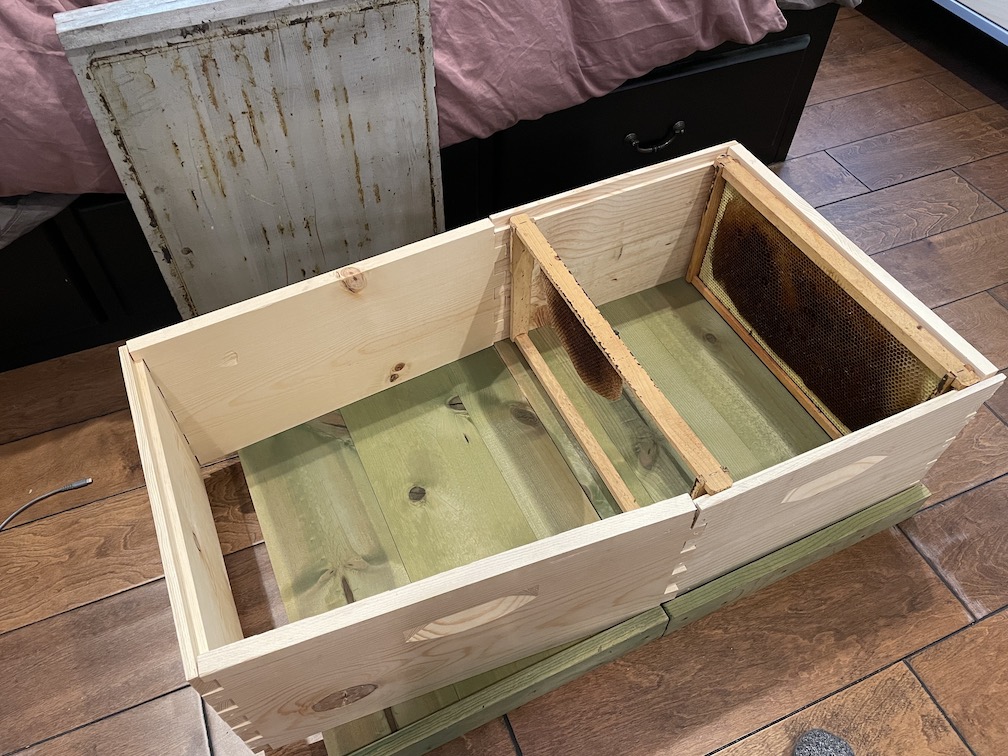
A normal Langstroth box has 2 long sides and 2 short sides. In the above photo the 3 wooden panels on the right side are standard, and I've inserted the 1st and the 10th frame to test focus, etc. What would normally be the 4th long side has been replaced by 2 longs and 1 short pieces in that trapezoidal shape to provide the working distance for the camera and LED panel, which are mounted against a modified short side. I'm alternating long and short sides as shown because of the way the standard pieces are notched. I'm terrible at carpentry, so I need to work with pre-fabbed pieces.
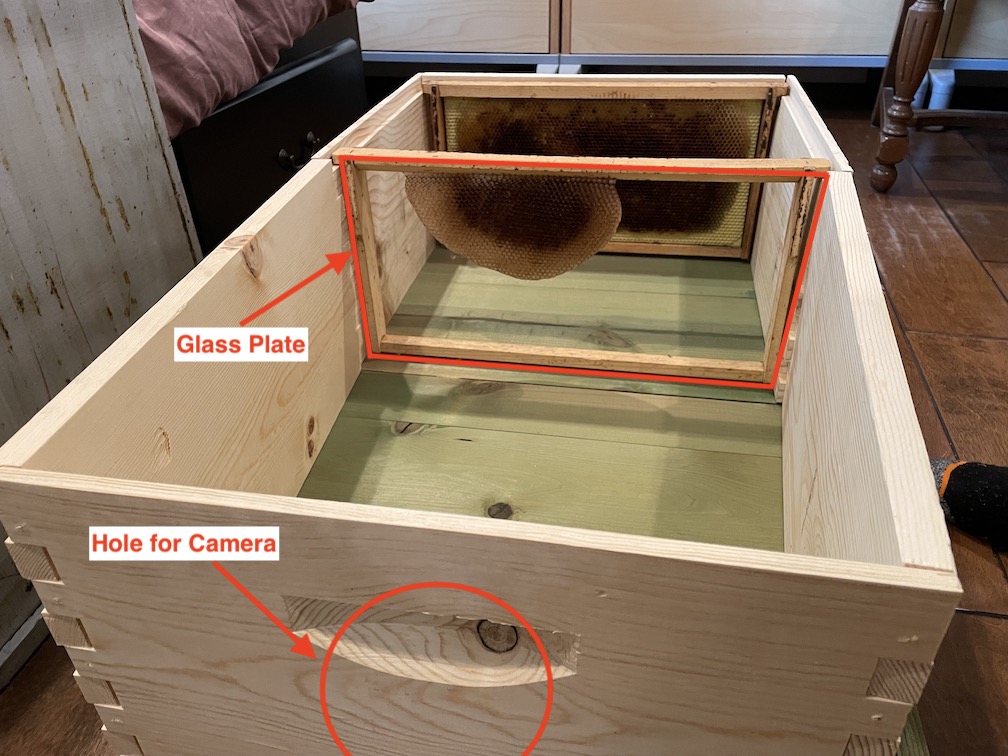
I changed my mind later, and I never put in that glass plate, because it's not necessary, and I didn't want glare/reflections/condensation issues. The bees don't care about the extra space.
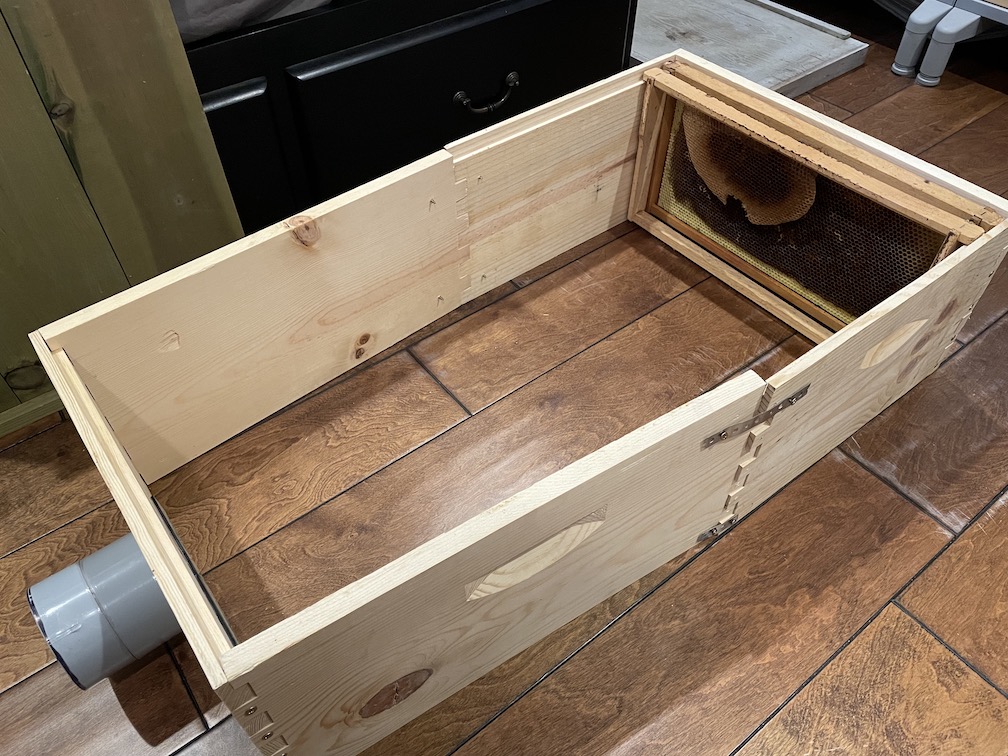
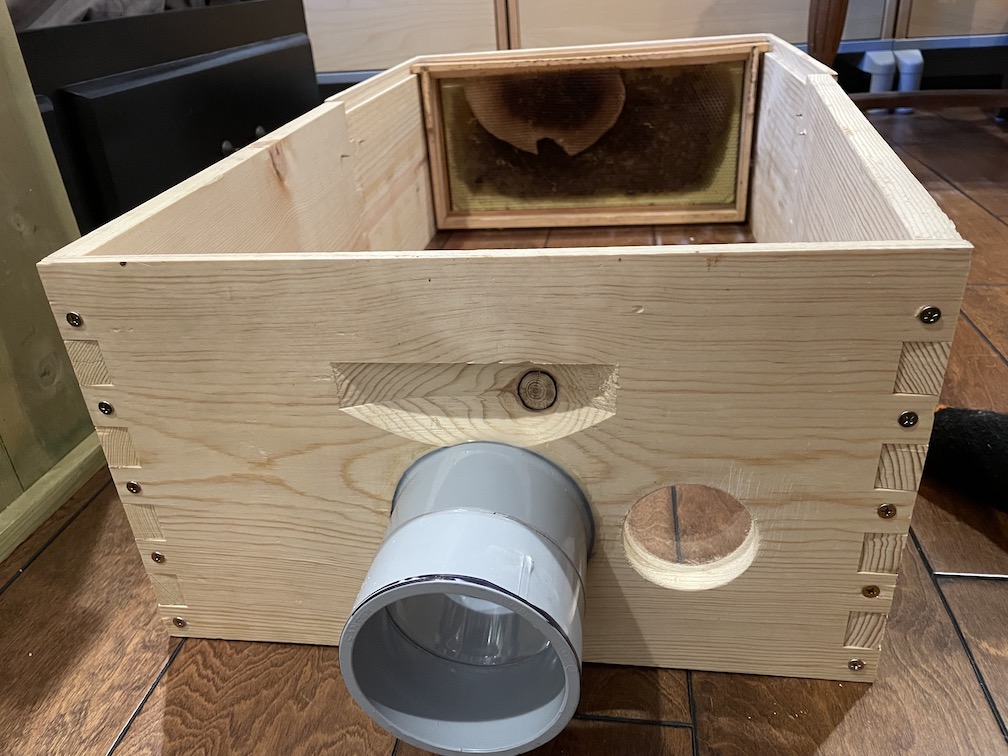
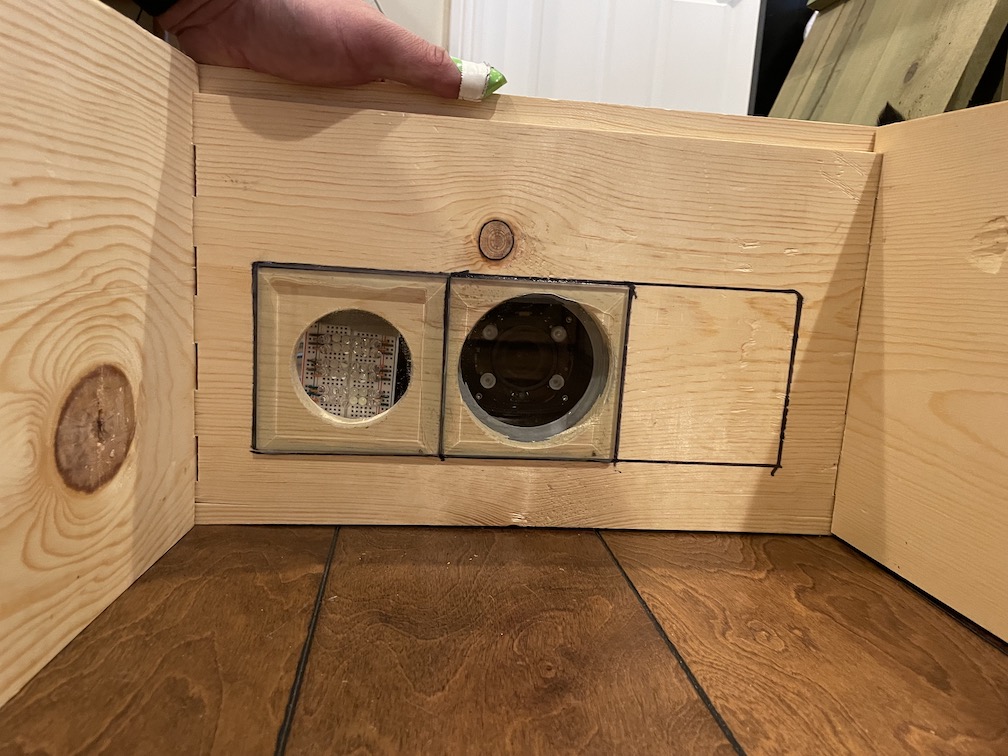
I have a Raspberry Pi mounted against the outside of the box to turn on the LEDs (behind a diffuser that's not shown), wait 20 seconds, and then curl a time-stamped JPG. Then once a day, or whenever I get around to it, I copy the JPGs to my Mac and combine them into an MP4 with ffmpeg.
Here it is with some covers on top. The bottom boards aren't shown, but when they're there they have a 3/8" gap at the bottom where the bees go in/out:
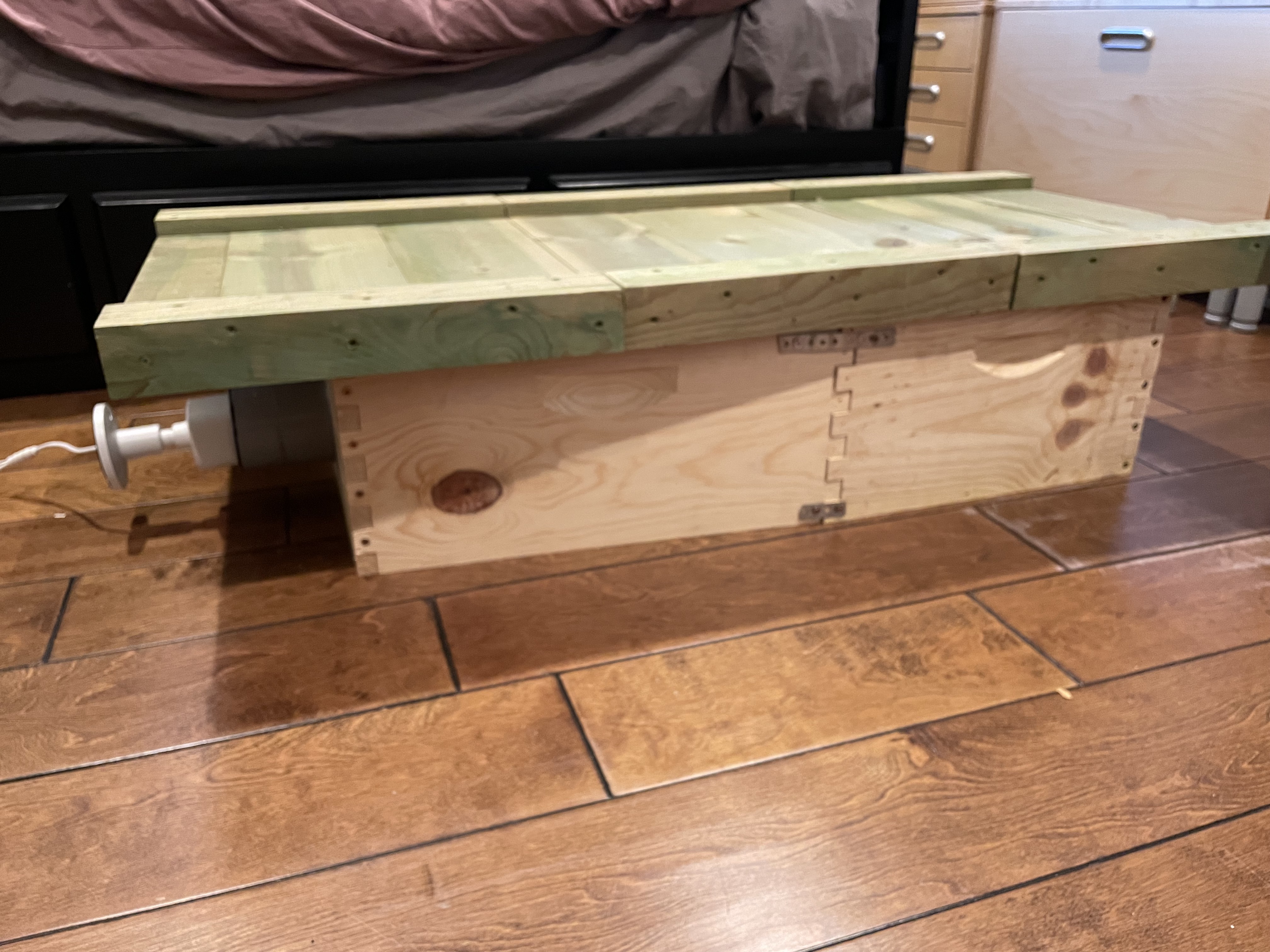
When I baited the swarm trap with a few frames of drawn (built) comb, I put it on the far wall, furthest from the camera, and then I filled the space with empty frames, until I had all 10 spaces filled. The bees will work from existing comb, because they like to keep clustered together, so they worked methodically towards the camera.
If they finish the 8th or 9th frame, they will work on the 10th frame, and possibly also start building comb in the next "space" adjacent to the 10th frame, which means building down from the bottom surface of the top board. I can't put a frame there, because the space is tapered, so it's too narrow, and those "long" sides don't have the shelf anyway. Even if the shelf were there I don't want to modify a frame, because then it will be the wrong size to move back into a standard box later. Having comb hanging off a lid is a management nightmare.
So, once they've filled the 10 frames, this experiment will end, and I'll move all the frames into a standard 10-frame box. I'll also move the entire colony 30' into my main bee yard.
Then I'll wait a week for the bees to forget about this location, set it all up again, and wait for a new swarm to move in!
I might use an old DSLR, for better image quality, which will take it out of the realm of IPCamTalk, but you can follow my progress over on BeeSource.

A normal Langstroth box has 2 long sides and 2 short sides. In the above photo the 3 wooden panels on the right side are standard, and I've inserted the 1st and the 10th frame to test focus, etc. What would normally be the 4th long side has been replaced by 2 longs and 1 short pieces in that trapezoidal shape to provide the working distance for the camera and LED panel, which are mounted against a modified short side. I'm alternating long and short sides as shown because of the way the standard pieces are notched. I'm terrible at carpentry, so I need to work with pre-fabbed pieces.

I changed my mind later, and I never put in that glass plate, because it's not necessary, and I didn't want glare/reflections/condensation issues. The bees don't care about the extra space.



I have a Raspberry Pi mounted against the outside of the box to turn on the LEDs (behind a diffuser that's not shown), wait 20 seconds, and then curl a time-stamped JPG. Then once a day, or whenever I get around to it, I copy the JPGs to my Mac and combine them into an MP4 with ffmpeg.
Here it is with some covers on top. The bottom boards aren't shown, but when they're there they have a 3/8" gap at the bottom where the bees go in/out:

When I baited the swarm trap with a few frames of drawn (built) comb, I put it on the far wall, furthest from the camera, and then I filled the space with empty frames, until I had all 10 spaces filled. The bees will work from existing comb, because they like to keep clustered together, so they worked methodically towards the camera.
If they finish the 8th or 9th frame, they will work on the 10th frame, and possibly also start building comb in the next "space" adjacent to the 10th frame, which means building down from the bottom surface of the top board. I can't put a frame there, because the space is tapered, so it's too narrow, and those "long" sides don't have the shelf anyway. Even if the shelf were there I don't want to modify a frame, because then it will be the wrong size to move back into a standard box later. Having comb hanging off a lid is a management nightmare.
So, once they've filled the 10 frames, this experiment will end, and I'll move all the frames into a standard 10-frame box. I'll also move the entire colony 30' into my main bee yard.
Then I'll wait a week for the bees to forget about this location, set it all up again, and wait for a new swarm to move in!
I might use an old DSLR, for better image quality, which will take it out of the realm of IPCamTalk, but you can follow my progress over on BeeSource.
When I posted my first pass at the Comb Building Time Lapse, someone suggested that I try to “remove the bees” and get video of just the comb.
I didn't really consider the suggestion, because I thought it impossible, until 2 days ago, when I thought, what if I could do a rolling average of, say, 10 frames? So frame 1 of my output would be the average of frames 1 - 10, and frame 2 of my output would be the average of frames 2 - 11, etc.
The results are amazing, IMNSHO. For your esteemed review, here is a comparison of:
1) The original with 1 frame per frame:
2) The result of a 10-frame rolling average:
2) The result of a 50-frame rolling average:
Besides the surreal visuals, the other benefit is that it’s not really affected by YT's “compression crush,” since the bees are reduced to ghosts anyway, and the comb is pretty much static.
Which is the most visually compelling?
I didn't really consider the suggestion, because I thought it impossible, until 2 days ago, when I thought, what if I could do a rolling average of, say, 10 frames? So frame 1 of my output would be the average of frames 1 - 10, and frame 2 of my output would be the average of frames 2 - 11, etc.
The results are amazing, IMNSHO. For your esteemed review, here is a comparison of:
1) The original with 1 frame per frame:
2) The result of a 10-frame rolling average:
2) The result of a 50-frame rolling average:
Besides the surreal visuals, the other benefit is that it’s not really affected by YT's “compression crush,” since the bees are reduced to ghosts anyway, and the comb is pretty much static.
Which is the most visually compelling?
Mike A.
Known around here
- May 6, 2017
- 4,199
- 7,067
That is cool.
Guess it depends on your objective. I like 2 better myself. With 3 you completely lose the action of the bees. Looks kind of like fungi growing. Better if you want to only see the development of the comb I suppose.
Guess it depends on your objective. I like 2 better myself. With 3 you completely lose the action of the bees. Looks kind of like fungi growing. Better if you want to only see the development of the comb I suppose.

